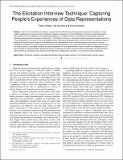The Elicitation Interview technique : capturing people’s experiences of data representations
Abstract
Information visualization has become a popular tool to facilitate sense-making, discovery and communication in a large range of professional and casual contexts. However, evaluating visualizations is still a challenge. In particular, we lack techniques to help understand how visualizations are experienced by people. In this paper we discuss the potential of the Elicitation Interview technique to be applied in the context of visualization. The Elicitation Interview is a method for gathering detailed and precise accounts of human experience. We argue that it can be applied to help understand how people experience and interpret visualizations as part of exploration and data analysis processes. We describe the key characteristics of this interview technique and present a study we conducted to exemplify how it can be applied to evaluate data representations. Our study illustrates the types of insights this technique can bring to the fore, for example, evidence for deep interpretation of visual representations and the formation of interpretations and stories beyond the represented data. We discuss general visualization evaluation scenarios where the Elicitation Interview technique may be beneficial and specify what needs to be considered when applying this technique in a visualization context specifically.
Citation
Hogan , T , Hinrichs , U & Hornecker , E 2016 , ' The Elicitation Interview technique : capturing people’s experiences of data representations ' , IEEE Transactions on Visualization and Computer Graphics , vol. 22 , no. 12 , pp. 2579-2593 . https://doi.org/10.1109/TVCG.2015.2511718
Publication
IEEE Transactions on Visualization and Computer Graphics
Status
Peer reviewed
ISSN
1077-2626Type
Journal article
Collections
Items in the St Andrews Research Repository are protected by copyright, with all rights reserved, unless otherwise indicated.

